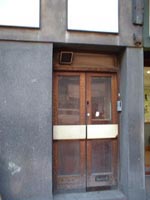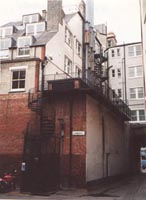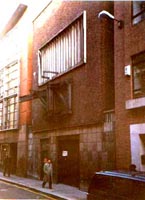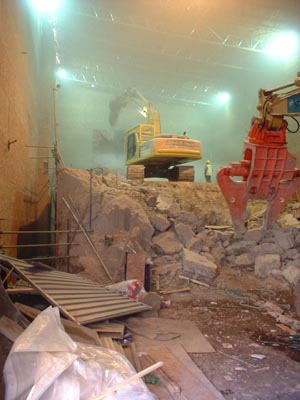HARDENED TELEPHONE EXCHANGE
beneath
Chancery Lane
UndergrounD
Station
HARDENED TELEPHONE EXCHANGE
beneath
Chancery Lane
UndergrounD
Station
The exchange utilized the twin Deep Shelter tunnels excavated under
Chancery Lane during the Second World War.
The tunnels were taken over by the GPO and extensions began in 1951
for a vast underground telephone exchange at Kingsway.
The backbone of the exchange was a twin tunnel 100 feet down on the
northern side of High Holborn, between Hatton Garden and Red Lion Square,
with Gray's Inn Road running over it. Eating, sleeping and working facilities
were provided on the Red Lion Square side. Telecommunications plant, generators
and repeating stations occupy most of the Hatton Garden side, while four
extension tunnels running beneath Chancery Lane underground station, house
switching units and a artesian well. A short tunnel links the exchange
with the PO's Holborn cable tunnel. The exchange opened in October 1954.
(London Under London p86)


The front of 32 High Holborn, the unassuming entrance to Kingsway Exchange

The rear of High Holborn. Note the air intakes and exhausts for generators.

Furnival Street heavy goods lift.

Tooks Court - Cursitor Street entrance now demolished

The Tooks Court - Cursitor Street entrance demolition, 2nd January
2001
All the surface stuructures are being demolished and the site will be
redeveloped with office buildings.
The contractors completely enclosed the site with acoustic and environmental
shielding.
The 10 foot thick walls and roof required specialist demolition.
The shaft to the exchange will be capped some distance below the surface,
when the basement is excavated.

The ventilator in Leather Lane.
The system was completed in 1954. The Soviet Union exploded their Hydrogen
bomb in 1955 and the complex became obsolete. However the PO persuaded
the government to finance 3 more extensions.
1) in the 50's to join the Faraday to the Covent Garden exchange.
2) 1966 joining the Trafalgar Square PO with Colombo House via Waterloo.
3) 1976 extending the Paddington tunnel to Shepherd's Bush.
(London Under London p187)
In 1939 the PO dug a second cable tunnel from the exchange under High
Holborn to its HQ at St.Martin's-le-grand where it formed a "T" with the
Wood Street tunnel. The Holborn Exchange at on end brought together the
telephone lines (links) with all the government departments and was a direct
link to Whitehall's own FEDERAL exchange. (e.g. FED 1234) and passed them
to the Faraday International Exchange at the other end of the tunnel.
The cable tunnel under Whitehall, which links up with the Whitehall
telephone exchange on Northumberland Avenue is still in use. The cold war
period saw growth for deeper, more secure communications.
Sir William Halcrow & Partners built most tunnels since the 30's.
Whitehall government tunnels, Post Office, deep shelters, PO railway, Victoria
and Jubilee lines, raw water mains.
Built by Halcrow, 8 miles long and 16.5 ft diameter. 2 ft gauge railway
(sic), later tunnels were smaller diameter and had battery powered trucks
to pull cables. They were well ventilated and well lit by fluorescent light.
Entrance to tunnels via Post Offices presumably exchanges or by manhole
covers dotted about. Easy to spot.
In December 1980 the staff of the New Statesman held their Christmas
party in one. Also tunnel from Colombo House (RAMPART) to Faraday
House (CITADEL) It crosses under the Thames at an angle just below
Blackfriars Bridge. These tunnels are connected to the government tunnels
under Whitehall and the 12 miles of Post Office tunnels stretching east
- west across London. final system - 3 more extensions. The system was
completed in 1954. ....post war Chancery Lane was taken over by the Post
Office and annexed to the Kingsway underground exchange.
(London Under London p184-187)
Secret London by Duncan has good description of cable tunnels p44.
"On a tour organized by Subterranea Britannica in 1995 we visited a
former MoD bunker directly beneath Chancery Lane tube station in central
London. There were inconspicuous entrances in High Holborn and Furnival
Street."
(The Guardian, N&Q April 23 1997)
To visit Duncan Campbell's
site and look at exceptional photos.
Click
here
The entrance to the Whitehall tunnel and Exchange is the first door on the left on entering the courtyard.
NB The authorities are very touchy about Craig's Court being photographed.